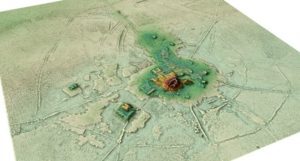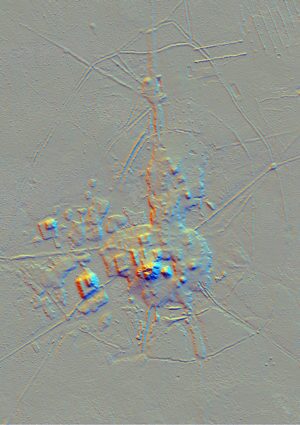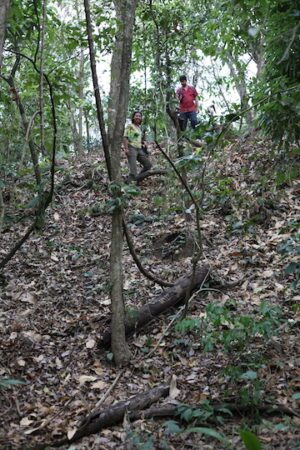
UNIVERSITY OF EXETER—A newly discovered network of “lost” ancient cities in the Amazon could provide a pivotal new insight into how ancient civilizations combined the construction of vast urban landscapes while living alongside nature.
A team of international researchers, including Professor Jose Iriarte from the University of Exeter, has uncovered an array of intricate settlements in the Llanos de Mojos savannah-forest, Bolivia, that have laid hidden under the thick tree canopies for centuries.
The cities, built by the Casarabe communities between 500-1400 AD, feature an unprecedented array of elaborate and intricate structures unlike any previously discovered in the region – including 5m high terraces covering 22 hectares – the equivalent of 30 football pitches – and 21m tall conical pyramids.
Researchers also found a vast network of reservoirs, causeways and checkpoints, spanning several kilometers.
The discovery, the researchers say, challenges the view of Amazonia as a historically “pristine” landscape, but was instead home to an early urbanism created and managed by indigenous populations for thousands of years.
Crucially, researchers maintain that these cities were constructed and managed not at odds with nature, but alongside it – employing successful sustainable subsistence strategies that promoted conservationism and maintained the rich biodiversity of the surrounding landscape.
The research, by Heiko Prümers, from the Deutsches Archäologisches Institut, Carla Jaimes Betancourt from the University of Bonn, José Iriarte and Mark Robinson from the University of Exeter, and Martin Schaich from the ArcTron 3D is published in the journal Nature.
Professor Iriarte said: “We long suspected that the most complex pre-Columbian societies in the whole basin developed in this part of the Bolivian Amazon, but evidence is concealed under the forest canopy and is hard to visit in person. Our lidar system has revealed built terraces, straight causeways, enclosures with checkpoints, and water reservoirs. There are monumental structures just a mile apart connected by 600 miles of canals, long raised causeways connecting sites, reservoirs and lakes.
“Lidar technology combined with extensive archaeological research reveals that indigenous people not only managed forested landscapes but also created urban landscapes, which can significantly contribute to perspectives on the conservation of the Amazon.
“This region was one of the earliest occupied by humans in Amazonia, where people started to domesticate crops of global importance such as manioc and rice. But little is known about daily life and the early cities built during this period.”
The team of experts used lidar technology – dubbed “lasers in the sky” – to peer through the tropical forest canopy and examine the sites, found in the savannah-forest of South West Amazonia.
The research revealed key insights into the sheer magnitude and magnificence of the civic-ceremonial centers found buried in the forest.
It showed that the core, central spread over several hectares, on top of which lay civic-ceremonial U-shaped structures, platform mounds and 21-m tall conical pyramids.
The research team conservatively suggest that the scale of labor and planning to construct the settlements has no precedents in Amazonia and is instead comparable only with the Archaic states of the central Andes.
Crucially, the research team insist this new discovery gives a pivotal new insight into how this ancient urbanism was carried out sustainably and embracing conservationism.
At the same time the cities were built communities in the Llanos de Mojos transformed Amazonian seasonally flooded savannas, roughly the size of England, into productive agricultural and aquacultural landscapes.
The study shows that the indigenous people not only managed forested landscapes, but also created urban landscapes in tandem – providing evidence of successful, sustainable subsistence strategies but also a previously undiscovered cultural-ecological heritage.
Co-author, Dr Mark Robinson of the University of Exeter added: “These ancient cities were primary centers of a regional settlement network connected by still visible, straight causeways that radiate from these sites into the landscape for several kilometers. Access to the sites may have been restricted and controlled.
“Our results put to rest arguments that western Amazonia was sparsely populated in pre-Hispanic times. The architectural layout of Casarabe culture large settlement sites indicates that the inhabitants of this region created a new social and public landscape.
“The scale, monumentality and labor involved in the construction of the civic-ceremonial architecture, water management infrastructure, and spatial extent of settlement dispersal, compare favorably to Andean cultures and are to a scale far beyond the sophisticated, interconnected settlements of Southern Amazonia.”
_______________________________

Screenshot from a 3D animation of the Cotoca site (Source: H. Prümers / DAI).
_______________________________

Lidar Image of the Cotoca site (MULTI-HS_D16_H15_RGB image, generated with “Relief Visualization Toolbox”) (Source: H. Prümers / DAI).
_______________________________

Co-author Carla Jaimes Betancourt descending from the central pyramid of the Cotoca site (Source: H. Prümers / DAI).
_______________________________
Lidar reveals pre-Hispanic low-density urbanism in the Bolivian Amazon is published in Nature.
Article Source: UNIVERSITY OF EXETER news release
_______________________________
Advertisement




